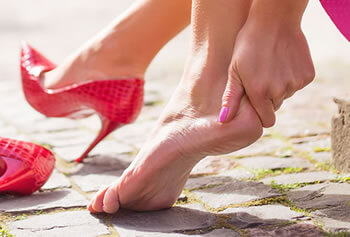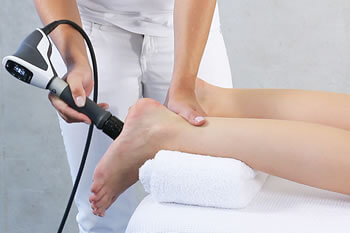
 The Heel Pain Center at Florham Park Podiatry is dedicated to the diagnosis and treatment of heel pain utilizing the most sophisticated diagnostic tools and most advanced treatment methods available.
The Heel Pain Center at Florham Park Podiatry is dedicated to the diagnosis and treatment of heel pain utilizing the most sophisticated diagnostic tools and most advanced treatment methods available.
We designed the Heel Pain Center of NJ around our physician’s expertly focused approach to the diagnosis and treatment of heel pain. Heel pain is a very common and often debilitating problem that is easily treatable given the right expertly trained physician, a wide variety of state-of-the-art treatment options, and a team dedicated to getting you comfortable as quickly as possible.
With the increased knowledge of plantar fasciitis and the advancements in treatment options, patients have an increased number of choices in their treatment. From advanced examination to diagnostic testing including dynamic ultrasound and MRI studies, our doctor will provide a comprehensive analysis of the cause of your heel pain.
We offer treatment options including orthotic care, injection therapy, shockwave therapy and advanced minimally invasive tissue repair techniques.
Our advanced heel pain treatment options include:
- Tenex Ultrasonic Plantar Fascia Therapy
- Shockwave Therapy
- and more!
Plantar Fasciitis & Other Heel Pain Conditions
Not all cases of heel pain are plantar fasciitis and multiple times per week, our podiatric foot and ankle specialists are advising patients of other sources of pain not previously diagnosed or treated.
Some associated possible sources of heel pain include:
- Plantar Fasciitis
- Calcaneal Heel Spur Syndrome
- Calcaneal Heel Bursitis
- Calcaneal Heel Nerve Entrapment
- Arthritis of the Heel
- Tarsal Tunnel Syndrome
- Heel Bone Tumor
- Heel Bone Cyst
- Heel Fracture or Stress Fracture
- Flexor Tendonitis/Tendinosis
ESWT SHOCKWAVE THERAPY

What is Extracorporeal Shockwave Therapy?
With years of research and FDA approval, Extracorporeal Shockwave Therapy (ESWT) is considered the most effective conservative treatment for chronic stubborn plantar fasciitis and Achilles tendonitis. This is an amazing option for someone needing more than conservative at-home treatments but may not ready for surgery.
Details of Shockwave Therapy Procedure
Shockwave therapy is an outpatient procedure. It uses high-energy acoustic waves to deliver a mechanical force to the body’s tissues. A probe is placed on the skin after a gel is applied to help conduct the shock waves. The device creates an energy wave that is focused on the area of concern. The shock waves create a force on the tissues that may improve blood flow to encourage the body to repair and heal itself.
The therapy is more successful with active patient participation where the patient tells the physician whether or not the probe is at the area of pain. One or more treatment sessions may be needed.
Do I Need Shockwave Therapy?
For chronic pain, extracorporeal shockwave therapy should be considered when conservative treatments fail. These treatments can include injections, physical therapy, and oral medications, among others. If shockwave therapy doesn’t work, the next step is usually surgery.
How Long Does Treatment Take?
The treatment is done in individual sessions lasting about 10-15 minutes each.
What Happens After the Procedure?
Patients typically bear weight after treatment and can resume normal activities unless your physician instructs you otherwise. Shock wave therapy may give good outcomes for some tendon problems or chronic degenerative conditions, including Achilles tendonitis and plantar fasciitis.
Heel Pain Issues in Children
Children, like adults, can suffer from Achilles stiffness, Achilles tendonitis and plantar fasciitis. The Heel Pain Center of NJ can help your child with these issues, in addition to those mentioned below:
- Sever’s Disease
- Pediatric Flatfoot
- Growth Plate Injuries
- Growing Pains
Read on to learn more about each condition.
Sever’s Disease
Sever’s disease (also called calcaneal apophysitis) is a painful bone disorder that results from the inflammation of the growth plate in the heel. The growth plate is an area at the end of a developing bone where cartilage cells change over time into bone cells. As this occurs, the growth plates expand and unite. This is how bones grow.
Sever’s disease is a very common cause of heel pain in kids, especially those who are physically active. It usually occurs during early puberty when kids grown most rapidly. Sever's disease rarely occurs in older teens because the back of the heel usually finishes growing by the age of 15, when the growth plate hardens and the growing bones fuse together into mature bone.
Read more about Sever’s disease, including symptoms, causes, and treatments.
Pediatric Flatfoot
Pediatric flatfoot refers to a partial or total collapse of the arch. Flatfoot can be apparent at birth, or it may not show up until years later. Most children with flatfoot have no symptoms, but some have one or more of the following symptoms:
- Pain, tenderness or cramping in the foot, leg and knee
- Outward tilting of the heel
- Awkwardness or changes in walking
- Difficulty with shoes
- Reduced energy when participating in physical activities
- Voluntary withdrawal from physical activities
If the child is experiencing symptoms, treatment is required. Your podiatrist may opt for one or more of the following approaches:
- Activity modifications: Temporarily decrease the child’s activities that bring pain and avoid prolonged walking or standing.
- Orthotic devices: Custom orthotic devices can be offered that fit inside the shoe to support the structure of the foot and improve function.
- Physical therapy: Stretching exercises (supervised by the foot and ankle surgeon or a physical therapist) provide relief in some cases of flatfoot.
- Medications: Non-steroidal anti-inflammatory drugs (NSAIDs), such as ibuprofen, may be recommended to help reduce pain and inflammation.
- Shoe modifications: Provide the child with the proper footwear that will support the foot and help ease symptoms.
- Surgery: In some cases, surgery is necessary to relieve the symptoms and improve foot function. The surgical procedure or combination of procedures selected for your child will depend on his or her type of flatfoot and degree of deformity.
Growth Plate Injuries
Growth plates are the areas of growing tissue near the ends of the long bones in the legs and arms in kids and adolescents. When a child’s skeleton has reached maturity, the growth plates harden and form complete bones. Before this growth is complete, the growth plates are at risk for fractures. An adult whose bones have finished growing might simply pull a muscle or a tendon after a fall, but that same could injure the growth plate of a developing child.
Most of the time, growth plate injuries happen from falling or twisting. Contact sports, like football or basketball, or fast-moving activities like skiing, skateboarding, sledding, or biking, are common causes. Injuries can also happen from activities that require repetitive training, like gymnastics, track and field, or pitching a baseball.
Treatment for growth plate injuries first involves resting and not bearing weight on the affected limb. Often, this means wearing a cast, splint, or brace over the area to prevent movement. If bones are out of place, they may have to be put back into place through a gentle procedure called a reduction. Afterward, the child may wear a cast, splint, or brace to make sure the bones don't move out of place.
Growing Pains
When a child complains of soreness in the legs it is frequently said that they are having "growing pains". On the contrary, the act of growing is not painful at all. "Growing pains" indicate that something abnormal is occurring. The muscles in the lower leg control the function of the foot. When the feet are not functioning properly it causes the muscles in the legs to fatigue. This fatigue results in soreness or cramping in the muscles of the legs. This may manifest itself early in development of the child. A newly walking child may prefer to be carried or held instead of exploring on their own. Youngsters may protest walking, tiring easily.
Treatment consists of using custom molded inserts for the shoes (orthotics) to correct the underlying abnormal foot function. This in turn reduces the stress experienced in the leg muscles and will ease or eliminate the soreness. The results can be quite dramatic with a rapid improvement in the child's symptoms.
